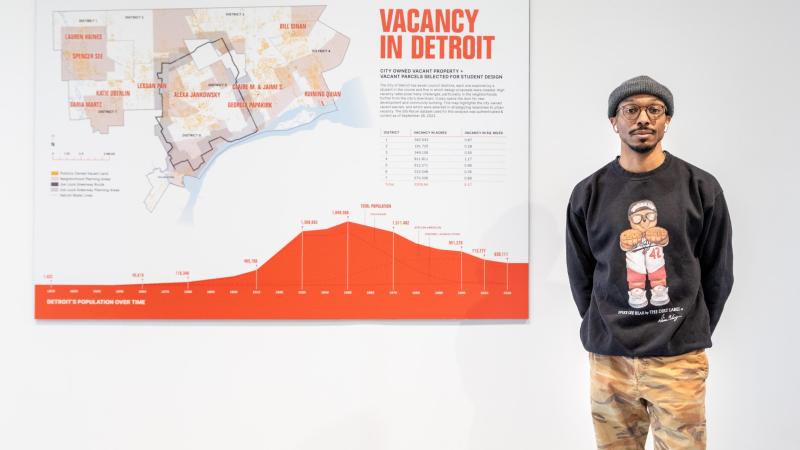What Could We Do Here? Urban Design Strategies for Vacant Land in Detroit
An exhibition of the 2022–23 Trott Visiting Professor Matt Williams

What Could We Do Here? Urban Design Strategies for Vacant Land in Detroit
Over the past hundred years, social structures in the United States and specifically in the Midwest have shifted. Industrial decline often brought employment fragmentation, population loss, and transformation in the physical environment through severe disinvestment, abandonment, and eventual demolition of obsolete buildings.
The terrain of these once-vibrant industrial centers has become overwhelmingly dominated by vacant land and structures. This shifting in society has disproportionately affected those most in need. The question remains how, despite extreme financial constraint, can Midwest cities respond to vacancy? No one solution fits all, even though the basic conditions of post-industrial cities may appear universal, they vary according to specific physical, social, and cultural conditions.
Of Detroit’s 139 square miles, which is characterized by predominantly single-family housing stock, there are 5.2 square miles of publicly owned vacant land, a reduction from 11.25 square miles in 2020. Privately owned parcels are responsible for a large amount of residential and commercial vacancy as well, though that data is not included in this analysis.
Addressing vacancy is crucial, demanding multiple urban design approaches to revitalization. Detroit is a dynamic city, with a population that demonstrates creativity and innovation infused with strength and resilience. In addition to being a pragmatic concern, the issues of vacancy that challenges Detroit and other post-industrial cities must be seen as a human issue and therefore addressed with respect to local heritage and traditions, fears and hopes.
In developing the urban design strategies that can transform vacant land and structures into physical assets, the role of the community is clearly paramount. A community-centric approach can lead to more sincere and meaningful resolutions. A range of solutions presented here recognize neighborhood assets, provide new avenues for economic development, and offer opportunities for neighborhood amenities such as recreation, parks and open space, and other activities.
In this exhibition, a combination of student work and real-world projects showcase Detroit as a ground-breaker in the search for urban designs that respond to issues of vacancy and abandonment and that can be widely applied to similar cities across the globe.
Curators
- Matt Williams, ASLA
- Ujijji Davis Williams, PLA
Student Contributors
- William Dinan
- Lauren Haines
- Alexa Jankowsky
- Tayyiba Kauser
- Daria Martz
- Claire Mei
- Regan Mohler
- Katie Oberlin
- Lexuan Pan
- Georgia Papakirk
- Smita Patil
- Ruining Qian
- Jaime Schmotzer
- Spencer See
- Brandeyn Seeger
Ohio State University
- Kristi Cheramie, FAAR
Professional Services
- Bold Design Studio - Carl Bolofer
- Zoyes Creative - Aimee Zoyes</h3>
Special Thanks
- City of Detroit Planning Department
- Detroit Historical Society

